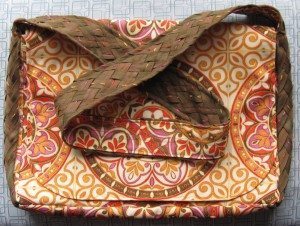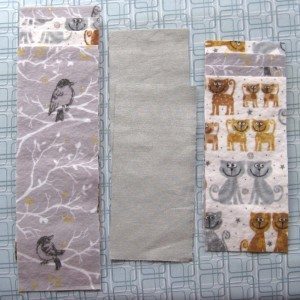And there was bag.
The main pocket has no additional pouches or pockets inside it, but there is a flat full-size pocket on either side opening to the outside. The flap, which covers nearly the entire front side when closed, has a secret zippered pocket that could hold pens or flash drives.
The width of this bag was determined by my laptop and its thickness by the width of the braided strap. The height may have been my laptop but was certainly influenced by whatever was necessary to have an entire fabric motif show on each outer pocket.
To make it, I lined the outside pockets and attached them flat to the sides. I constructed the flap pocket on one side of the flap by first adding a strip of fabric to each end of the zipper to extend it the width of the flap. Then I sandwiched the zipper tape between pieces of lining and outer fabric. The lining is stitched away from the zipper through the seam allowances on both sides, and then the upper piece folds down across the zipper. The bottom pocket seam is above the bottom flap seam, largely because I was working with stash fabric for the lining and that was as big as it got, but they share side seams.
I used interfacing on the outer pockets but nowhere else. This was partly because the construction of this bag was so spread out that I’d forgotten by the time I got to the main lining, but partly because I didn’t want the bag to get too heavy.
The strap is machine stitched at the top and bottom of each side and hand-stitched in between to stay nice and smooth. If I’d known in advance how long the strap needed to be I would have constructed the bag from the bottom up, but I did the bottom last, which was slow and awkward. Oh well! It turned out fine. I added the flap before I added the bottom because I couldn’t decide what order things should go in or whether I should machine-stitch the straps all the way down, and I needed to make sure I could fold the top edge down if so. That made finishing it up feel super fast – all that laborious sewing the bottom and hand-stitching the straps, and then boom, just slip the lining in, sew around the top, and done!
Or not done, actually, because as soon as I put my laptop in the strap stretched way out to the point of being uncomfortable. I tried an idea I’d had a while ago: machine-sewing along the center of each strip of twill tape that wasn’t decorated with embroidery floss. I wished the whole time that I’d done it before making the bag because it was quite awkward. AND it didn’t even work. I had to back the strap with bag fabric to take the weight, and attach it less-than-perfectly where the straps meet the bag itself. At first I really hated how the strap came out, but now that I’m used to it, I think it’s all right.
At any rate, now I have a fairly lightweight and pleasingly comfortable cross-body laptop bag that I can use to walk or bike to meetings all summer long.









